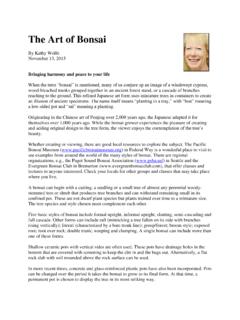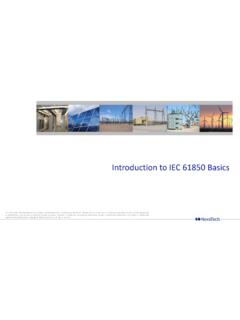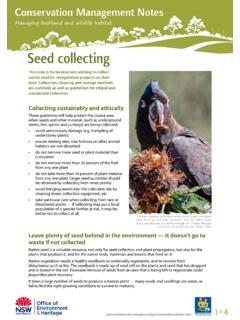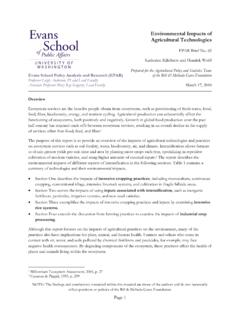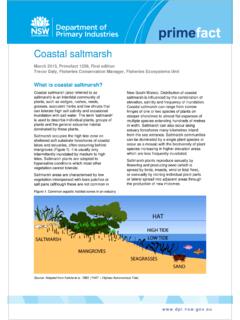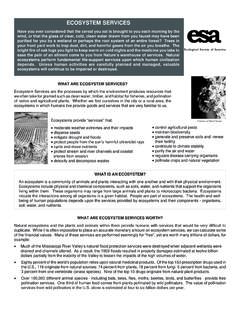Transcription of Sustainable Agriculture: An Introduction
1 What is Sustainable Agriculture? Sustainable agriculture is one that produces abundant food without depleting the earth s resources or polluting its environment. It is agriculture that follows the principles of nature to develop systems for raising crops and livestock that are, like nature, self-sus-taining. Sustainable agriculture is also the agriculture of social values, one whose suc-cess is indistinguishable from vibrant rural communities, rich lives for families on the farms, and wholesome food for everyone. But in the first decade of the 21st Century, sus-tainable agriculture, as a set of commonly accepted practices or a model farm economy, is still in its infancy more than an idea, but only sustainability in agriculture is tied to broader issues of the global economy, de-clining petroleum reserves, and domestic food security, its midwives were not gov-ernment policy makers but small farmers, environmentalists, and a persistent cadre of agricultural scientists.
2 These people saw the devastation that late 20th-Century farming was causing to the very means of agricul-tural production the water and soil and so began a search for better ways to farm, an exploration that continues to this 20th-Century agriculture took industrial production as its model, and verti-cally-integrated agri-business was the result. The industrial approach, coupled with sub-stantial government subsidies, made food abundant and cheap in the United States. But farms are biological systems, not mechani-cal ones, and they exist in a social context in ways that manufacturing plants do not. Through its emphasis on high production, the industrial model has degraded soil and water, reduced the biodiversity that is a key element to food security, increased our dependence What is Sustainable Agriculture? ..1 How Do We Achieve Sustainability? ..2 Know Your Markets, Protect Your Profits, and Add Value to Your Products.
3 3 Build Soil Structure and Fertility ..3 Protect Water Quality on and Beyond the Farm ..4 Manage Pests Ecologi-cally; Use Minimal Pesticides ..4 Maximize Biodiversity on the Farm ..5 How Can I Learn More About Sustainable Agriculture? ..6A Publication of ATTRA, the National Sustainable Agriculture Information Service 1-800-346-9140 is the national sustain-able agriculture information service operated by the National Center for Appropriate Technol-ogy, through a grant from the Rural Business-Cooperative Ser-vice, Department of Agricul-ture. These organizations do not recommend or endorse prod-ucts, companies, or individu-als. NCAT has offices in Fayetteville, Arkansas, Butte, Montana, and Davis, California. ATTRAC ontentsBy Richard Earles; revised by Paul Williams, NCAT Program Specialist NCAT 2005 Sustainable Agriculture: An IntroductionPhoto courtesy USDA NRCSPage 2 ATTRAS ustainable Agriculture: An Introductionon imported oil, and driven more and more acres into the hands of fewer and fewer farmers, crippling rural communities.
4 In recent decades, Sustainable farmers and researchers around the world have responded to the extractive industrial model with ecol-ogy-based approaches, variously called natu-ral, organic, low-input, alternative, regenera-tive, holistic, Biodynamic, biointensive, and biological farming systems. All of them, rep-resenting thousands of farms, have contrib-uted to our understanding of what sustain-able systems are, and each of them shares a vision of farming with nature, an agro-ecology that promotes biodiversity, recycles plant nutrients, protects soil from erosion, conserves and protects water, uses mini-mum tillage, and integrates crop and live-stock enterprises on the no matter how elegant the system or how accomplished the farmer, no agriculture is Sustainable if it s not also profitable, able to provide a healthy family income and a good quality of life. Sustainable practices lend themselves to smaller, family-scale farms.
5 These farms, in turn, tend to find their best niches in local markets, within local food sys-tems, often selling directly to consumers. As alternatives to industrial agriculture evolve, so must their markets and the farmers who serve them. Creating and serving new mar-kets remains one of the key challenges for Sustainable Do We Achieve Sustainability?Farmers and other agricultural thinkers have established a strong set of guiding principles for sustainability, based on stewardship and economic justice. Producers and researchers are annually increasing the pace of improve-ments in agro-ecology systems, making them more efficient and profitable. More Coopera-tive Extension offices and colleges of agricul-ture are endorsing Sustainable practices. And every year more farmers are seeing the wis-dom and rewards both economic and per-sonal in these systems. (Organic products are the fastest growing grocery segment in the United States.)
6 Little by little one crop, one field, one family at a time Sustainable farming is taking the farm, consumers and grassroots activ-ists are working to create local markets and farm policies that support Sustainable prac-tices. They are working to raise consumers awareness about how their food is grown and processed how plants, animals, the soil, and the water are treated. And they are working to forge stronger bonds between producers and consumers that will, in time, cement the foundations of locally and regionally self-sufficient food systems. In contrast to mono-cropped industrial megafarms that ship throughout the world, the vision of sustain-able agriculture s futurists is small to mid-size diversified farms supplying the majority of their region s food. (No one in Idaho has to give up orange juice, and there will still be cranberries in California for Thanksgiv-ing.)Listed below are some of the key consider-ations for making a farm more Sustainable , along with relevant ATTRA publications in those areas.
7 Because each farm is differ-ent, there s no single formula for Sustainable success, but these principles and publica-tions are good places to begin learning what Jam processed on-farm is one example of a value-added product. Photo by Nathalie by little one crop, one field, one family at a time sustain-able farming is taking will take. And for a more detailed look at some of these same fundamentals, see the ATTRA publication Applying the Principles of Sustainable Your Markets, Protect Your Profits, and Add Value to Your ProductsDiversify outside the commodity supply chains and corporate vertical direct marketing and pre-mium specialty forming a cooperative with other value through on-farm ManagementEvaluating a Rural EnterpriseMoving Beyond Conventional Cash CroppingEntertainment Farming and Agri-TourismAgricultural Business Planning TemplatesEnterprise Budgets and Production Costs for Organic ProductionPreparing for an Organic Inspection.
8 Steps and ChecklistsDirect MarketingFarmers MarketsCSA (Community Supported Agriculture)Bringing Local Food to Local InstitutionsSelling to RestaurantsOrganic Certification and the National Organic ProgramOrganic Marketing ResourcesAlternative Meat Marketing 444444444444444 USDA-RBS Series on CooperativesKeys to Success in Value-added AgricultureAdding Value to Farm Products: An OverviewGrain ProcessingOilseed Processing for Small ProducersFood Dehydration OptionsSoyfoods: Adding Value to SoybeansSorghum SyrupValue-added Dairy OptionsBuild Soil Structure and FertilityReduce the use of synthetic fertilizers by increasing on-farm nutrient fertilization decisions based on soil or eliminate of the soil not only as a physical and chemical substrate but as a living entity; manage the soil organisms to pre-serve their healthy ground cover year-round by using cover crops and mulches and by leaving crop residues in the Soil ManagementDrought Resistant SoilNutrient Cycling in PasturesManures for Organic Crop Production444444444 4444No-till soybeans growing through wheat stubble in Kansas.
9 Photo courtesy USDA peaches at a farmers market in Cali-fornia. Photo by Erik 4 ATTRAS ustainable Agriculture: An IntroductionOverview of Cover Crops and Green ManuresOverview of Organic Crop ProductionFarm-scale Composting Resource ListConservation TillagePursuing Conservation Tillage Systems for Organic Crop ProductionAssessing the Pasture Soil ResourceAlternative Soil Testing LaboratoriesAlternative Soil AmendmentsSources of Organic Fertilizers and AmendmentsProtect Water Quality on and Beyond the FarmUse soil-building practices that increase soil organic matter and support a biologi-cally active humus soil conservation practices that re-duce the potential for water runoff and perennial crops such as forages, trees, and catch crops or cover crops to take up nutrients that may otherwise leach into the buffer areas between fields and water bodies to protect against nutrient 444444444 and sediment movement into lakes and irrigation to enhance nutrient uptake and decrease nutrient livestock in pasture-based Cycling in PasturesProtecting Water Quality on Organic FarmsProtecting Riparian AreasManaged Grazing in Riparian AreasConservation EasementsMontana Irrigator s Pocket GuideConstructed WetlandsConservation TillageSustainable Soil ManagementDrought Resistant SoilSustainable Pasture ManagementAgroforestry OverviewManage Pests Ecologically; Use Minimal PesticidesPrevent pest problems by building healthy, biologically active soil; by creat-ing habitat for beneficial organisms.
10 And by choosing appropriate plant the farm as a component of an eco-system, and take actions to restore and enhance pest predator balances. Under-stand that the mere presence of a pest does not necessarily constitute a prob-lem; base any intervention on monitoring 444444444444 Streams without conser-vation buffers run higher risks of streambank erosion, contamination with farm chemicals, and sedimentation, as well as offer no habitat for wildlife. Photo by Lynn Betts, USDA beetles look for aphids on a fava bean leaf. Scientists think the beetles might help in controlling Russian wheat aphids that now infest 17 Great Plains and Western states. Photo by Scott Bauer, USDA (crop scouting) and economic damage intervening with a chemical, posi-tively identify the pest species and learn about its life cycle and ecology. Imple-ment cultural practices that alter the cropping system and surrounding habi-tat to make life more difficult for the pest and easier for its natural pesticides as the last resort, when biological and cultural controls have failed to keep pest populations below eco-nomically damaging levels.







